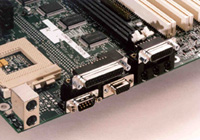 Photo ©1998 AMP INC.
Photo ©1998 AMP INC.The use of strip metals for connector springs, terminals, contacts, and switches is well accepted in the interconnection industry. This is particularly true for copper alloys, because of their desirable combination of conductivity, strength, and formability.
The connector designer will approach each new assignment with information on a connectors desired mechanical characteristics, operating environment and life expectancy. His task is to find a specific design which can be reliably and economically manufactured. To accomplish this goal he must find the copper alloy and temper which will allow the connector to be manufactured, assembled and used successfully throughout its intended life, all at minimum cost.
Copper alloy strip enables engineers to meet initial performance criteria and also to ensure continued reliability. The designer can specify certain properties of the strip which in combination will provide the necessary initial contact force and subsequent mechanical stability. To do this he must choose among published data on various properties, such as hardness, modulus of elasticity, yield strength, tensile strength, ductility, electrical conductivity, thermal conductivity , stress relaxation resistance, fatigue resistance, corrosion resistance, as well as formability, dimension and shape availability, and cost. These properties, which are directly relevant to performance and reliability, are defined as follows:
- corrosion resistance The ability of a metal to avoid undesirable changes due to interaction with its environment.
- ductility (%El) The elongation of a specimen which has been stretched to rupture in a tensile test is often used as a measure of ductility. For connector design, bend test data is more relevant. (See "formability.")
- electrical conductivity (%IACS) Data are usually expressed as a percentage of a known material, the International Annealed Copper Standard.
- fatigue resistance The ability of a metal to minimize the decrease in strength which occurs from repeated stress applications.
- formability (R/t) The ability of a metal to bend, usually expressed as the minimum bend radius (R) divided by the strip thickness (t).
- hardness There are many measurement scales for this property, which has little real significance, but which is vaguely indicative of strength and is mainly notable for the simplicity and low cost of the required test.
- modulus of elasticity (E) The ratio of stress to strain in a material under elastic load. Most available data has been obtained under tension, although most connector designs utilize cantilever beams, for which load application in bending would be more relevant.
- tensile strength (TS) The maximum load sustained in tensile straining of a specially-shaped specimen divided by the cross-sectional area of the specimen at the start of the test.
- thermal conductivity A measure of the ability of a material to conduct heat. Commentator 1 - Units? Value?
- stress relaxation resistance The gradual decrease in stress which occurs over time when a specimen is subject to a constant strain. Most copper alloy data is obtained in bending and at a moderately elevated temperature. Commentator 1 - Units? Temp?
- yield strength (YS) Most published data presents the stress which will produce an offset extension of 0.2%.
The next several topics relate strip properties and connector requirements.
-
-
- Performance Requirements
- Electrical and Thermal Conductivity
- Discussion of Conductivity
- Conductivity of Alloy Classes
- Conductivity of Brass
- Conductivity of Phosphor Bronze
- Conductivity of Specialty Alloys
- Strength Versus Conductivity
- Modulus of Elasticity
- Contact Force
- The Brasses
- Phosphor Bronze
- Higher Strength Alloys
- Formability
- Directionality of Formability
- Other Requirements
-
